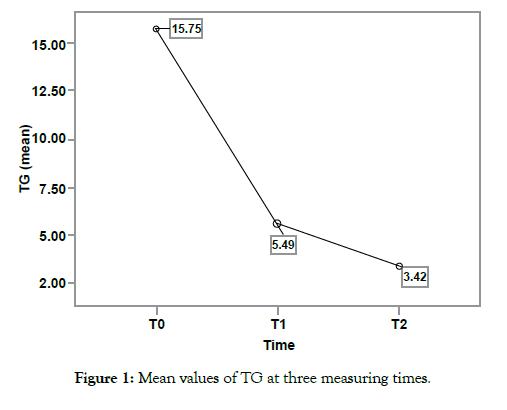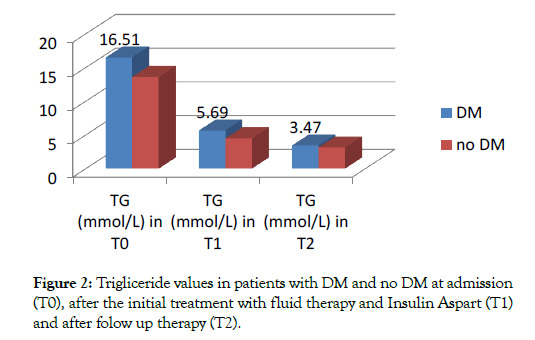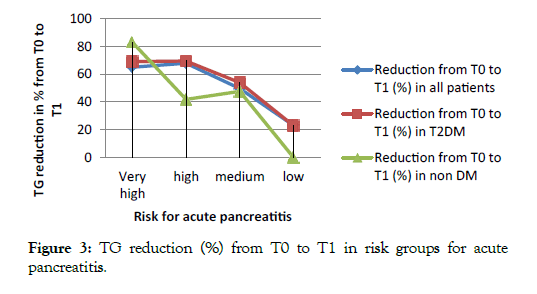Research Article - (2020) Volume 11, Issue 9
Introduction: High levels of triglycerides (TG) in the serum can cause acute pancreatitis. Contrarily, there is a proven benefit of the rapid decrease of triglycerides. Although the exact mechanism is unknown, a lot of studies showed that lipoprotein lipase stimulated via insulin reduces triglyceride values.
Aim: Our aim of the study is to prove the treatment benefits with fluids and intravenous rapid insulin in patients with type 2 diabetes and their role of decreasing the risk of acute pancreatitis due to high TG (above 5,6 mmol/L/500 mg/dL) and very high TG (above 11.3 mmol/L/1000 mg/dL), as a result of lipoprotein lipase activity.
Patients and methods: this is interventional follow-up study in 40 patients with hypertriglyceridemia, treated with fluids (Glucose 5%) and rapid insulin Aspart in infusion. All patients were hospitalized at admission (T0) at university clinic of endocrinology – Skopje, treated and monitored for the risk of hypoglycemia (T1). Follow up visit (T2) were done in outpatient clinic. Lipid parameters were compared in all three visits.
Results: Out of 40 patients, 15 were women (37.5%) and 25 man (62.5%). The average age was 43 years. Of the total number, 34 patients had T2DM and 85% of them HbA1c>7.5% (av. HbA1c=10.3%). Six patients (15%) had no DM. At reception, the average TG value was 15, 7 mmol/L. Only 3 patients had TG<5,6 mmol/L. Patients were treated on average with 4150 ml of Dx 5% and insulin Aspartfor an average of 79 U. After 3 days, significant TG reduction was observed, (5.49 mmol/L, p<0.001). On follow up for average 9 months, patients were treated with fenofibrate and/ statin therapy (in those with statin therapy the dose was halved), TG reduction of 3.4 mmol/L (p<0.001) was observed in the group.
Conclusion: Rapid decrease of TG values after few days of treatment with fluids and rapid acting insulin Aspart has been observed in patients with high TG values and a risk of acute pancreatitis in type 2 DM patients with a poor glucose regulation and in non DM patients. TG values gradually reduced their value after applying statins and/or fibrates in the therapy.
Hypertriglyceridemia; Fuids; Insulin
Hypertriglyceridemia (HT) is the 3rd biggest cause of acute pancreatitis (AP). National cholesterol Education Program ATP III categorizes triglyceride (TG) levels as normal (<1.7mmol/L), borderline high (1.7-2.25 mmol/L), high (2.26-5.64), and very high (>5.65 mmol/L) [1]. Hyperglyceridaemia may be primary (like type I, IV, V hyperlipoproteinaemia) or secondary (like uncontrolled diabetes mellitus, alcoholism, pregnancy, obesity, utilisation of some drugs). The typical clinical profile of hypertrigliceridemic pancreatitis (HTAP) is a patient with a preexisting lipid abnormality along with the presence of a secondary factor (e.g., poorly controlled diabetes, alcohol use, or a medication) that can induce HT [2,3]. Typically, TG>11.3 mmol/L have been associated with AP. Approximately 10% of AP are as a consequence of hypertriglyceridemia [4]. Studies suggest that in patients with triglyceride (TG) levels>11.3 mmol/L, hypertriglyceridemia-induced acute pancreatitis (HT-AP) occurs in approximately 15–20% of all subjects referred to Lipid Clinics. Until now, there is no clear evidence which patients with severe HTG TG>(11.3 mmol/L) will develop pancreatitis and which of them will not [5]. Triglyceride levels above 5.6 mmol/L are common thresholds for initiating lipid-modifying agents for reducing the risk of developing pancreatitis. It is thought that values triggering acute pancreatitis often exceed 22.6–33.9 mmol/L (very severe hypertriglyceridemia). In contrast, a rapid decrease in triglyceride level is beneficial. Insulin-stimulated lipoprotein lipase is known to decrease serum triglyceride levels. Apart from conventional methods of treatment, several less frequently used methods have been described in the literature to decrease the triglyceride levels rapidly, e.g. plasmapheresis, apoliprotein CII infusion, and use of insulin and heparin. While there are many case reports and series demonstrating TG lowering effect, there are no comparison studies evaluating insulin versus conservative therapy [6,7]. Insulin is a potent triglyceride (TG)-lowering agent that acts by promoting the synthesis of lipoprotein lipase which is the crucial enzyme for the hydrolysis of TG. Insulin activates lipoprotein lipase (LPL) activity which in turn accelerates chylomicron degradation thus lowering TGs levels. The objective of medical treatment is to increase lipoprotein-lipase activity, and to increase chylomicron breakdown, thus diminishing serum triglycerides to levels below 5,6 mmol/L or even 2.26 mmol/L (when possible) using a variety of strategies, including insulin administration [8]. While there are many case reports and series demonstrating TG lowering effect, there are no comparison studies evaluating insulin versus conservative therapy [9]. Insulin lowers TGs levels by 50-75% over 2-3 days. Cases of successful management of HT-AP have been reported even in nondiabetic patients without concomitant serum glucose elevation (75% drop in serum TGs in 24 hours) [10]. In patients with severe HTG, immediate lowering of the TG level to below 11.3 mmol/L is possible with insulin infusion, while long-term maintenance therapy can be provided with utilization of other pharmacological agents, such as fibrates, niacin and fish oil [11]. The mainstay of treatment includes dietary restriction of fat, fluid treatment with glucose 5% and insulin, lipid-lowering medications (fibrates and/ or statin therapy, alpha lipoic acid). According to ATP 3 guidelines, fibrates remain the drug of choice for severe HTG with niacin as adjunctive therapy [1].
The Aim of this study was rapid reduction of TG levels to well below 5.6 mmol/L which can effectively prevents episodes of pancreatitis.
This is interventional follow-up study conducted in inpatient clinic with high/very high levels of triglycerides for the first time. Patients were selected into two groups: with type 2 diabetes (T2DM) and without diabetes (No DM). HbA1c at admission was measured in all patients with T2DM. Patients were divided in 4 groups according triglyceride levels and the risk for acute pancreatitis: low risk (TG<5,6 mmol/L), medium risk 5,6-11.2 mmol/L, high risk 11,3-22.2 mmol/L and very high risk >22,3 mmol/L. After the diagnostic methods, (lipid measurements – total cholesterol, HDL-C, LDL-C, Triglycerides, HbA1c for those with diabetes), all patients with the high levels of triglycerides were treated immediately in accordance to reduce risk for acute pancreatitis. In all patients at admission (visit T0) treatment with fluids (glucose 5%), intravenous rapid insulin aspart, diet restriction was initiated immediately and after few days, after the goal was reached, they have been released from the hospital. Plasma glucose was measured before each treatment and after the fluid therapy was finished. Follow up outpatient treatment was continued (visit T1, visit T2).
From 40 patients with hypertriglyceridemia, 15 were women (37.5%) and 25 men (62.5%). There were no significant gender differences in the analyzed parameters at three measurement points. Out of 40 patients, 36 of them had type 2 diabetes and 6 without diabetes. The average age was 43 years in group with T2DM and 47 years in group without DM. The correlations between age and all analyzed parameters were not significant at three measurement points.
Of the total number of patients with DM, 30 had HbA1c>7.5% (av.HbA1c=10.3%), while 4 had HbA1c<7,5% (Table 1).
Table 1: Mean age, HbA1c and lipid profile in diabetic and non-diabetic patients at admission (T0).
| T0 | Age | HbA1c | TG | Total Chol | HDL Chol | LDL Chol |
|---|---|---|---|---|---|---|
| Mean (All) | 43.5 | 10.11 | 15.73 | 9.63 | 0.78 | 5.9 |
| Mean T2DM | 43 | 10.11 | 16.5 | 9.1 | 0.82 | 2.9 |
| Mean non DM | 47 | N/A | 13.6 | 12.1 | 0.6 | 7.7 |
The mean TG levels at admission were 15.73 mmol/L (N:40) in all patients, 16,51 (N:34) in patients with T2DM vs 13,63 mmol/L. (N:6) in non DM patients. No statistical significance was shown between groups with DM and non DM (p>0.05).
Other parameters for lipid profile were of no significance because of the small group of analysis in non DM patients,(p>0.05). From the analyzed patients, the group with no DM had higher levels of total cholesterol and LDL cholesterol.
A repeated-measures ANOVA determined that mean TG scores differed significantly across three time points (F = 69.04, p<0.001). A post hoc pairwise comparison using the Bonferroni correction showed a reduced TG score between the initial assessment, the assessment after treatment with fluids and insulin Aspart, and follow-up assessment 9 months later (15.75 (T0)vs. 5.49 (T1)vs. 3.42 (T2), respectively). However, the decrease in TG score reached significance when comparing either the initial assessment to the assessment after the initial treatment (15.75 vs. 5.49, p<0.001) or the assessment after the treatment (T1) and follow-up assessment 9 months later (T2) (5.49 vs. 3.42, p<0.001). Therefore, we can conclude that the results for the ANOVA indicate a significant time effect for mean TG values both after treatment and at followup (sustainability for avg. 9 months or later in the group) (Figure 1).

Figure 1: Mean values of TG at three measuring times.
At the time of treatment with fluid therapy and insulin Aspart in infusion from T0 to T1 there was significant negative correlation of initial HbA1c values and TG values at the assessment after initial treatment (T1) (r= -.529, p=0.002) (Figure 2).

Figure 2: Trigliceride values in patients with DM and no DM at admission (T0), after the initial treatment with fluid therapy and Insulin Aspart (T1) and after folow up therapy (T2).
According the initial treatment with fluids and insulin Aspart, there was significant positive correlation of the volume (in mL) of initial fluid treatment and total units of applied Insulin Aspart (r=.928, p<0.001). The mean duration for the treatment with fluids and insulin Aspart was 3 days (Table 2).
Table 2: Mean Total fluid and insulin Aspart in T2DM and non DM patients with hypertriglyceridemia.
| All | Type 2 DM | No DM | |
|---|---|---|---|
| N | 40 | 34 | 6 |
| Total fluid in ml | 4150 | 4400 | 2800 |
| Insulin Aspart (total U) | 79 | 84.7 | 47.7 |
According the risk group for acute pancreatitis, the distribution of the reduction of TG levels in patients was as follows: in T0 22,5% with very high risk, 40% with high risk, 30% medium risk and 7,5% with low risk. After the initial treatment, in T1 the risk was as follows: 0% with very high risk, 7.5% high risk, 10% medium risk and 67.5% low risk and in the follow up period in T2: 0% with very high risk, 0 % high risk, 5% medium risk and 95% low risk for acute pancreatitis (Table 3).
Table 3: Patients with hypertriglyceridemia and the risk categories for acute pancreatitis
| Risk category for acute pancreatitis | Very high (>22,6 mmol/L) | High (11,3-22.6 mmol/L) | Medium (5,6-11,2 mmol/L | Low (<5.6 mmol/L) |
|---|---|---|---|---|
| N (%) in T0 | 9 (22.5) | 16 (40) | 12 (30) | 3 (7.5) |
| Avg TG T0 (at admission) | 31.11 | 14.87 | 8.26 | 4.32 |
| N (%) in T1 | 0 | 3 (7.5) | 10 (25) | 27 (67.5) |
| Avg in TG in T1 | 9.25 | 4.78 | 4.16 | 3.32 |
| N (%) in T2 | 0 | 0 | 2 (5) | 38 (95) |
| Avg TG in T2 | 4.29 | 3.1 | 3.1 | 3.83 |
Table 4: Average fluids and insulin Aspart in T1 according the risk groups for acute pancreatitis
| Risk category for acute pancreatitis | Very high (>22,6 mmol/L) | High (11,3-22.6 mmol/L) | Medium (5,6-11,2 mmol/L | Low (<5.6 mmol/L) |
|---|---|---|---|---|
| N | 9 | 16 | 12 | 3 |
| Total fluid in ml | 4400 | 4700 | 3400 | 4000 |
| Insulin AspartU | 75.1 | 96.7 | 62.5 | 61.7 |
From 40 patients 27 of them (67.5%) have achieved TG<5,6 mmol/L after initial treatment (T1), respectively 38 (95%) in T2 after the treatment was continued with fibrates and/statins.
According the total fluid therapy, total dose of insulin As part in correlation with risk for acute pancreatitis, patients with very high and high risk for acute pancreatitis needed more fluids and insulin As part for reducing the TG levels (p<0.05).
After the initial treatment in all risk categories for acute pancreatitis it is marked reduction of TG levels 50 % or more - in very high risk group 65%, and in high risk group 67.85% (Figure 3).

Figure 3: TG reduction (%) from T0 to T1 in risk groups for acute pancreatitis
In non-diabetic patients (N 6) reduction from T0 to T1 in TG levels was marked (in very high risk group for 83%, in high risk group 41.8% and in medium risk group 47.65%).
Predictors of TG at the assessment after treatment (T1) are TG at T0 (p<0.01) and initial fluid treatment at T0 (p=0.025).
Hypertrigliceridemia alone or as part of dyslipidemia is a frequent pathology in endocrine units especialy in patients with diabetes with poor glucose regulation as isolated diabetic hypertrigliceridemia or diabetic dyslipidemia. Loret et al, in his study concluded that Twenty percent of patients with severe hypertriglyceridemia experience at least 1 attack of AP. The Data from European population studies also show AP incidence of 10-19% of patients with severe HTG (2). In our study group of patients with hypertrigliceridemia and the risk for acute pancreatitis, most of the patients were associated with poorly regulated T2DM (85%) and the rest of them without DM (15%).
All 40 patients were treated with the same protocol after the diagnosis and risk categorisation for acute pancreatitis was made. Initial Fluid therapy (glucose 5%) and rapid acting insulin Aspart in infusion was given during three consecutive days. Coskun et al in his study report for 12 cases of HT-induced AP that were successfully treated by insulin and concluded that Insulin lowers TGs levels by 50-75% over 2-3 days (7). In our study, the initial treatment with fluids and insulin Aspart, showed significant positive correlation of the volume (in mL) of initial fluid treatment and total units of applied Insulin Aspart with the outcome of TG decrease for 65% after the initial treatment and sustainable TG levels for 9 months with treatment with fibrates and/statins for 79.3%. After the initial treatment and classification according the risk for acute pancreatitis, in our study group it is marked reduction of TG levels in very high risk group for 65%, and in high risk group for 67.8%. From all 40 patients, 27 of them (67.5%) have achieved TG<5,6 mmol/L after initial treatment (T1), respectively 38 (95%) in follow-up therapy in T2 after the treatment was continued with fibrates (n=16, 40%) fibrate and statin (n=12, 30%) and statins alone (n=12, 30%). Diet restriction, physical activity 30 minutes/ day, krill oil omega-3 fatty acids capsules were prescribed in all patients. Intensive monitoring and blood glucose monitoring before the initial fluid treatment and during the treatment was safely measure to prevent hypoglycemia. No hypoglycemia was appeared during the initial fluid therapy in all 40 patients. In this group, 52.5% of treated patients at T0 were associated with low HDL levels (dyslipidemia).
Hypertriglyceridemia is a common clinical problem that can be seen in many medical conditions. A remarkable rise in triglyceride levels may lead to acute pancreatitis, which is a serious and fatal complication. Fluid therapy with glucose 5% and rapid insulin analogue may be used safely and effectively in inpatient hospital in patients with high/very high levels of triglycerides for reducing and preventing the risk of acute pancreatitis.
Our results are comparable with the literature and sustainable for a mean period of 9 months. Long term study and more evaluation are needed to compare clinical outcome of this method of treatment for prevention of acute pancreatitis in primary and secondary hypertriglyceridemia.
Citation: Ahmeti I, Misevska SJ, Mihajlovska X, Stojkoska IM, Jakupi SA, Mijakoski D (2020) Severe Hypertriglyceridemia and The Risk for Acute Pancreatitis Treated with Fluids and Rapid Insulin in Type 2 Diabetes and Non-Diabetic Patients. J Diabetes Metab. 11:855. doi: 10.35248/2155-6156.20.11.855
Received: 18-May-2020 Published: 25-Sep-2020, DOI: 10.35248/2155-6156.20.11.855
Copyright: © 2020 Ahmeti I, et al. This is an open-access article distributed under the terms of the Creative Commons Attribution License, which permits unrestricted use, distribution, and reproduction in any medium, provided the original author and source are credited